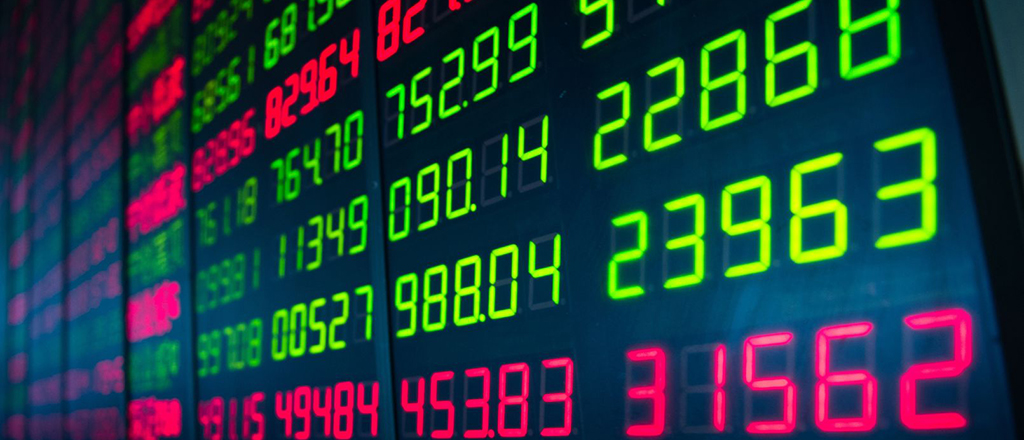With investors straining to see what’s next in U.S. stock markets after three dark days that erased some $4 trillion in value globally — just after many new highs — Wharton finance professor Jeremy Siegel noted midday Tuesday that the recent losses are an overdue correction. Now markets appear fairly valued. “The market went up too far, too fast in January,” Siegel said of the strongest New Year rise in history. There were a “lot of momentum players … trend followers … they have what they call stop orders in for selling [at a certain price] … and they jumped off the train. … ” January’s “crazy ride is over.” The moves in recent days “blew the fluff off” after having so many days of 200-point gains in January, he added, suggesting they did not portend much larger drops ahead.
The Dow Jones Industrial Average plunged the most ever on February 5 — on a point, though not on a percentage, basis — giving the market whiplash following so many days of record-highs in recent months. With the S&P 500 and the Nasdaq both posting losses around 4%, and global markets also taking a big hit, it was a surprise return to volatility despite what appeared to be a calmer day at midday Tuesday. At the low point Monday, however, the Dow had shed close to 1,600 points.
Will the market go down much more? “It might, but I think those buying now are OK for longer-term investments. Sit pat,” Siegel said. For those who are sitting on some cash and have been wondering what to do, “this may be the time to put some in” for those who felt the market “got away” from them.
Siegel added that longer-term trends for the economy look strong, so strong that he believes the Fed may raise interest rates four times in 2018 rather than the three most have forecasted. The reason: Continued strong jobs numbers may already be leading to wage-push inflation, and Siegel said that the Fed will be very sensitive to that. At the current unemployment rate of 4.1%, should current rates of job growth continue — 150,000 to 200,000 per month — unemployment may drop to 3.5% by year end. Almost all analysts would say that would create an inflation rate unacceptable to the Fed. Job growth of around 50,000 per month in the current economy would be closer to an equilibrium level.
Last month, Siegel predicted a possible correction of up to 10% in U.S. equity markets at some point during 2018. He also forecast that the market would end the year somewhere between being flat and up 10%. That made him, for the first time in life, he said, the most bearish person in the studio when he appeared on CNBC recently to discuss his market outlook. He called Monday’s drop in the Dow a “pipsqueak” at 4.5% compared to a one-day drop of more than 22% back in 1987.
Siegel offered his views on the Knowledge@Wharton show, which airs on SiriusXM channel 111. (Listen to the podcast above). An edited transcript of the conversation follows.
Knowledge@Wharton: What is your read on the last three days of trading when we had the market correction?
Jeremy Siegel: The market went up too far, too fast in January. I had said so [before the current decline]. What we had was a lot of momentum players. These are trend followers. [They get in as] the market goes up 100 points, 200 points every day. They said, “Hey, I’m going to ride this train.” And more and more jumped on. And they all said, “I’ll jump off when it stops.”
“I think the market was 10% overvalued.”
So now everyone has. Once it goes down a certain amount — for some people it may be a 1%, 2%, 3% decline in the market — it triggers what they call their stop [loss] orders in for selling. As soon as it breaks through that, they jump off the train and that’s what we had yesterday [Feb. 5]. Everyone said okay, “This crazy ride in January is over. I’m taking my profits and I’m jumping off.” And that’s basically what it is.
Now there’s always a trigger. It’s usually a minor trigger — rising interest rates, the Friday employment report, which reported some pretty strong wage gains and the yield on the 10-year [Treasury note] rising to 2.85%. These are the little things that get people nervous enough to have one foot ready to jump off.
Knowledge@Wharton: Is this a momentary retreat? Will we see a moderate rebound on Wall Street in the next few days?
Siegel: Yes. I think the market was 10% overvalued. Last December I called for [growth in the U.S. stock market] this year to be zero to 10%. And as the market kept going up, they said, “Oh, Dr. Siegel, you’re way to bearish.” Now, you know, for someone to call me too bearish is [unusual].
Knowledge@Wharton: That’s never the case.
Siegel: I was on CNBC and I was the most bearish forecaster there. I said, “I don’t think I’ve ever been in that position my whole life.” I also said, “Listen, the market went up late last year in anticipation of the corporate tax cut.” And that was okay. I was all for it. I think it was a good thing. And then it has kept on going up again because … they kept on using the same rationale to keep doing it. And then of course, it became its own self-fulfilling prophecy. And everyone jumped on and on and on.
There’s an old, old saying in the market, “up a staircase, down the elevator.” And that’s what we had. If you take a look at the graph of high-low daily closes in January — it was up, up, up like a stepladder — then down the elevator.
Knowledge@Wharton: What will be the path of the Fed now, at least this year, and especially with the switch from Janet Yellen to Jerome Powell?
Siegel: It seems like every new chair gets a challenge. Remember two months after Alan Greenspan came in, we had [the Black Monday market crash of] October 1987. This is a pipsqueak challenge in comparison to that — we had a 4.5% decline yesterday [on Feb. 5] compared to a 22% decline [in the 1987 crash]. We also had yields on the 10-year soaring to 10% — a totally different situation … much worse than what we had.
Knowledge@Wharton: Will many people get out of the market or buy on the dip?
Siegel: Once you get these things, you get a lot of volatility. Will it go down more? It might. I think, though, the people buying now are okay for a longer-term investment. I think it was a bit pricey a week or two ago. Now my feeling is sit pat — unless you’re a short-term trader and love trading volatility, which very few people do successfully — so I urge most people not to try that. I say you sit pat at this particular point.
If you’ve got some money that you’ve kind of been waiting to put in the market and felt it ran away from you, maybe this is the time to put some of it in — realizing, certainly, it could go a bit lower before it ultimately gets higher. Right now, I look at a really fairly valued market. I don’t see a real undervalued market. I think we blew off the fluff of that crazy, every day 200-point gain that seemed to be the first four weeks of this year.
“People buying now are okay for a longer-term investment.”
Knowledge@Wharton: What does this do to commodities?
Siegel: It’s interesting. Oil is down. [But] you did ask about the Fed and I didn’t get a chance really to answer. Let me go to the Fed first because what we’ve seen so far will have zero impact on the Fed. So the Fed is raising [interest rates] in March. The only way this could have an impact is if it gets much worse and we see a slowdown. Let’s face it, since Trump was elected, we’ve had a 40% gain in the Dow. So we gave back 10%. This is nothing that in a bigger picture would cause the Fed to go, “we have to hold off raising rates.” Now again, if the decline gets worse, if they see a real slowing of economic activity which we have not — then it’s another picture. But from the data that’s coming in now, no way is the Fed going to pause March at this point.
Knowledge@Wharton: All of the economic data and the jobs numbers have continued to be positive.
Siegel: The big problem with the market this year is, I say it’s a clash between the numerator and the denominator. What do I mean by that? The value of stocks is earnings divided by the interest rate, the discount rate. And earnings are going up but the discount rate’s going up too. So the question is, which is going to go up the fastest?
And what happened over the last week when we had that strong job gain and we also had a nine-year high in year-over-year earnings gains? All of a sudden people said, “That interest rate’s going up. That denominator’s going up. I’m going to have to discount these earnings,” even though the earnings are great. Yes, there was a stumble in ExxonMobil, and Apple’s sales are not maybe what some people expected, but overall forecasters are raising their estimates of 2018 earnings.
Knowledge@Wharton: You still have a lot of companies that say that they are either going to be adding jobs or bringing back cash … building factories and continuing to add production.
Siegel: Yes. The danger for stock investors is not a slowing economy, it’s an overheating economy. And you asked about commodities. They’ve been very firm. Now we’ve seen a bit of a selloff in oil but don’t forget, that’s come on the back of huge gains. A lot of us didn’t think oil would get above $60. It almost got to $70 and now it’s in the low $60’s. We’ve had huge gains because the coordinated expansion of worldwide business has increased the demand for oil — and more optimism on that.
Commodity prices are firming. They’re not out of control. We don’t have anything like the 1970s inflation. But firming of those commodity prices is one of the factors the Fed looks at and that is another reason why I believe — certainly at this point unless the market gets much worse — an interest rate increase in March is in the bag.
Knowledge@Wharton: I want to go back to something you mentioned about wage growth which, I believe, was 2.9% in January from the year before. How does that correlate to the concern about interest rates?
Siegel: This is important. Wage growth is good. If it’s caused by productivity growth, then it’s great. We’ve had a little bit of firming of productivity growth but not enough. This wage growth looks in excess and that increases what we call unit labor cost, which puts cost pressures on firms that induces them to pass through these cost pressures into final prices.
“The danger for stock investors is not a slowing economy, it’s an overheating economy.”
Now this could take a long time and I wouldn’t panic yet. We’ve had this one month, you know, year-to-year increases but with the unemployment down to 4.1 % — well below what the Fed thinks is the natural rate of unemployment — it sparks wage increases. With the gains we see in employment — we had 200,000 [in January] — if we get 150,000 to 200,000 new jobs per month through the remainder of this year, we’re going to be not only below 4%, we may be below 3.5% and I don’t know any case in post-World War II history where that has not brought about rapid wage gains that have to move into prices.
Knowledge@Wharton: The fact that you could be even looking at an unemployment rate that is in the 3.5% range —
Siegel: Is amazing.
Knowledge@Wharton: What about the labor participation rate, which is still down below 63%.
Siegel: But stabilized, in the last four years
Knowledge@Wharton: Do you think that rate has the ability to go higher? It used to be like 66%, right?
Siegel: Don’t forget, we have the demographic [effect] — the Boomers’ retiring is a wave of force that’s dragging it down. So the only way it could rise now is if people get so optimistic about [finding a job,] people who are not looking, now will say, “There are such great opportunities there, I’m going to start looking.” And to some extent, that’s what’s been happening. But it has to overcome the steady retirement of the boomers, which is accelerating at this time.
That’s why the participation rate actually peaked in the year 2000 and going down — it went down very rapidly during the economic crisis more than economists expected. Now it’s stabilized and it has hit the trend line of what economists expected.
Knowledge@Wharton: Is the 62% or 63% range in the labor participation rate the new norm now?
Siegel: In fact, I think it’s going to continue to drift downward over the next 10 years.
Knowledge@Wharton: Really?
Siegel: Yes, because of the Baby boomers. We’re an aging population. Don’t forget, it’s not those aged 18 through 65. It’s … actually everyone over 16. I’m not sure what the cutoff is. So as Baby Boomers retire, that rate is in a secular decline.
… Actually, one of the very few areas where the participation rate is rising is among those over 65. They’re coming back because they don’t have enough savings. But they’re still a very small group — they can’t offset the tidal wave of retirement of the Baby Boomers. From immigration and population alone, we’re generating 50,000 to 80,000 jobs. We can’t continue to add 150,000 to 200,000 jobs and not lower that unemployment rate.
Knowledge@Wharton: Do you expect three rate increases this year?
Siegel: You know, I’m beginning to think four. And no one knows until the data evolves. … But again, unless we have a slowdown in job growth that’s significant, I think now the Fed is going to raise it at every quarterly meeting.
This article is republished courtesy of Knowledge@Wharton. Copyright Wharton School of the University of Pennsylvania.









